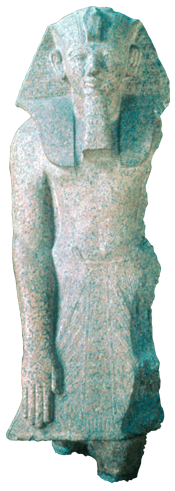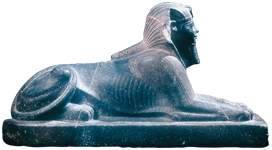TALES FROM THE CRYPTS
The blockbuster exhibit The Quest for Immortality: Treasures of Ancient Egypt at the Museum of Science examines life—and the afterlife—in that lost civilization
by Scott Roberto
 The
mysterious and long-lived culture of ancient Egypt has fascinated people
throughout the world since archaeologists first began to uncover its
sepulchral wonders nearly 200 years ago. From films like The Mummy—both
the 1932 version starring Boris Karloff and its modern update—to pop songs
like The Bangles’ 1986 hit “Walk Like An Egyptian,” artists and
entertainers have borrowed, and at times misrepresented, aspects of this
noble and complex society. Indeed, the awe-inspiring architecture and
seeming preoccupation with death are the first things many think of when
the subject of ancient Egyptian culture arises. But there’s far more to
that bygone desert kingdom than King Tut and pharaoh’s curses.
The
mysterious and long-lived culture of ancient Egypt has fascinated people
throughout the world since archaeologists first began to uncover its
sepulchral wonders nearly 200 years ago. From films like The Mummy—both
the 1932 version starring Boris Karloff and its modern update—to pop songs
like The Bangles’ 1986 hit “Walk Like An Egyptian,” artists and
entertainers have borrowed, and at times misrepresented, aspects of this
noble and complex society. Indeed, the awe-inspiring architecture and
seeming preoccupation with death are the first things many think of when
the subject of ancient Egyptian culture arises. But there’s far more to
that bygone desert kingdom than King Tut and pharaoh’s curses.
Just witness The Quest for Immortality: Treasures of Ancient Egypt, the new international blockbuster exhibit currently on view at the Museum of Science. The only stop in the northeastern United States on its five-year journey around North America, this grand spectacle features over 100 artifacts, more than any previous exhibition of objects outside of Egypt. Although just about all the pieces on display come from tombs—as does most of the evidence that forms the basis of our knowledge of this culture—the ancient Egyptian’s preparations for the afterlife spoke volumes about the enjoyment of their daily lives.
Tomb paintings, for instance, often showed Egyptians participating in sports and games. And since they believed you really could “take it all with you,” many items found at gravesites were those used or worn in everyday life. Jewelry and furniture are two elements desired in the next world. And the various bracelets, necklaces and the like, as well as the meticulously re-created wooden furniture from the tomb of Fourth Dynasty Queen Hetepheres on loan from the Museum of Fine Arts, speak not only of their skilled craftsmanship but their appreciation of beauty as well.
| Stone-faced—Two tributes to Pharaoh Thutmose III (the sculpture, top and sphinx, bottom right) dating back to over 3,000 years ago are on loan from the Egyptian Museum in Cairo as part of The Quest for Immortality exhibit at the Museum of Science. |
 rth
in the afterlife.
rth
in the afterlife.Another highlight, and a unique feature to the Boston stop of the exhibit, is a section on mummification that showcases an actual mummy. Although the exact identity of the deceased, on loan from Emory University in Atlanta, remains unknown, much information about his life has been gleaned from the remains. Recently scanned at Boston’s Beth Israel Deaconess Medical Center using 3-D technology, the mummy’s health, personal history and appearance have been reconstructed, all without disturbing what lies beneath its dusty wrappings.
Going along with the everything-Egypt theme, the Museum of Science is also resurrecting the IMAX movie Mysteries of Egypt, which screens at the Mugar Omni Theater. Narrated by the late Egyptian actor Omar Sharif, the film explores the wonders of that land, with soaring perspectives on the pyramids at Giza, the temple at Luxor and the Valley of the Kings, the final resting place of many New Kingdom pharaohs, including the famed boy-king Tutankhamun. In addition, the Charles Hayden Planetarium showcases Stars of the Pharaohs, which places observers in the heart of the Nile Valley to view the celestial canopy as it appeared 4,000 years ago.
The Charles River may not resemble the Nile,
but visitors can certainly experience the sights and sounds of ancient
Egypt along its shores. So head over to the Museum of Science. It may be
your only chance to see these once-lost treasures in this life—and perhaps
the next one as well.

back to homepage